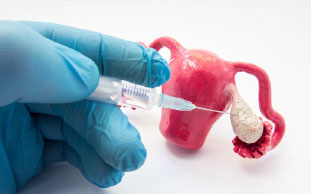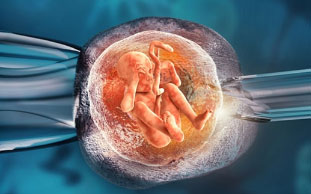If you and your partner are considering fertility treatment, you may need to decide whether or not you would like to pursue ovulation induction. Fertility treatments are often used in combination with various drugs that are designed to help trigger ovulation. Before undergoing any type of fertility treatment, be sure to speak with your reproductive endocrinologist about ovulation induction.
What is Ovulation Induction?
Ovulation induction is a type of medical therapy often performed alongside certain fertility treatments. Typically, medications that are used to help trigger the development of egg follicles are known as ovulation inducers. Ovulation induction often triggers the development of more than one egg during ovulation.
Why Induce Ovulation?
Ovulation is often induced in order to help women who cannot ovulate regularly produce an egg during their monthly cycle. Ovulation induction is also used in order to trigger the ovaries to release more than one egg during ovulation. Sometimes, inducing ovulation can allow two or three eggs to be released at once, therefore increasing your chances of pregnancy.
Who Can Benefit from Ovulation Induction?
A large percentage of women seeking fertility treatment can benefit from ovulation induction. In particular, women suffering from the following conditions may find ovulation induction particularly helpful in increasing their chances of pregnancy:
- Anovulation
- PCOS (Polycystic Ovarian Syndrome)
- Pituitary disorders
- Irregular menstruation (oligomenorrhea)
What are the factors Affecting Ovulation Induction?
There are certain factors that will affect the success of ovulation. Before choosing ovulation induction, your reproductive endocrinologist will evaluate:
- your egg quality
- your egg quantity
If the quality and quantity of your ovarian reserve is poor, ovulation induction may not be the right route for you.
Types of Ovulation Inducers
1. Clomid
Clomid, or clomiphene citrate, is one of the most well known ovulation inducers. Clomid is a relatively inexpensive fertility medication and can usually be used with limited monitoring. However, it does require some blood testing, so it should only be used with the supervision of your reproductive endocrinologist.
How Is Clomid Taken?
Clomid is taken orally, on specific days of your menstrual cycle. It is typically on through Days 3 to 7 or through Days 5 to 9. It is sometimes paired with Provera, a medication that can help to induce menstruation. The initial dose of Clomid is taken immediately after your menstrual period begins. This dose is typically around 50 milligrams, although it can be increased if ovulation does not occur.
After Ovulation Begins
Your reproductive endocrinologist will monitor you for ovulation. When an egg is released, you and your partner will engage in timed intercourse, in order to increase the chances of conception. Fertility treatments, including IUI will also begin at this time.
Clomid Success Rates
Clomid is usually highly successful in inducing ovulation. Between 50% and 80% of women taking Clomid will begin to ovulate. However, this does not necessarily mean that you will be able to achieve pregnancy. Pregnancy rates per cycle are typically between 10% and 15%, however this depends upon the type of fertility treatment that you and your partner are using. Pregnancy rates with Clomid are lower because the medication can sometimes compromise the quality of your eggs and cervical mucus.
2. Injectable Gonadotropins
Injectable gonadotropins are also used to help induce ovulation in certain women. This medication works to induce ovulation as it contains FSH(follicle stimulating hormones). FSH helps to trigger the development of follicles inside of your ovaries, triggering ovulation. This type of fertility medication is more expensive then Clomid. As many as six ampules of the medication may be required for every injection day.
How are Gonadotropins Taken?
Gonadotropins are also taken on specific days of your menstrual cycle. Intramuscular injections containing the gonadotropins are usually adminstered by your care giver for a period of eight to 14 days. As your follicles begin to show signs of maturation, you will also receive an injection of hCG(Human chorionic gonadotrophin (hCG) a glycoprotein hormone), to help induce ovulation.
After Ovulation Begins
After ovulation begins, you and your partner will be instructed to have timed intercourse, or to make an appointment to begin IUI treatments.
Gonadotropin Success Rates
Gonadotropin is highly successful when it comes to inducing ovulation. More than 70% of women taking this drug begin to ovulate. Pregnancy rates per cycle are generally around10 – 15% . However, gonadotropin is not without its side effects. There is a risk of multiple births when using gonadotropins to stimulate ovulation. Approximately 15% of all pregnancies are twins, and 3% are triplets or higher order multiples. There is also a risk for developing hyperstimulation, in which your ovaries become enlarged, and your abdominal area becomes swollen with fluid. This can be avoided with proper monitoring.
3. Metformin :
Doctors use this medicine for women who have insulin resistance and/or Polycystic Ovarian Syndrome (PCOS). This drug helps lower the high levels of male hormones in women with these conditions. This helps the body to ovulate. Sometimes clomiphene citrate or FSH is combined with metformin. This medicine is usually taken by mouth.
4. Bromocriptine & Cabergoline
These medicines are used for women with ovulation problems due to high levels of prolactin . Prolactin is a hormone that causes milk production which also suppresses ovulation.
They are highly effective at restoring normal ovulation and menstruation. More than 90% of women using bromocriptine/cabergoline, experience normal menstrual cycles. They are not associated with an increased risk for multiple births or with ovarian hyperstimulation.








